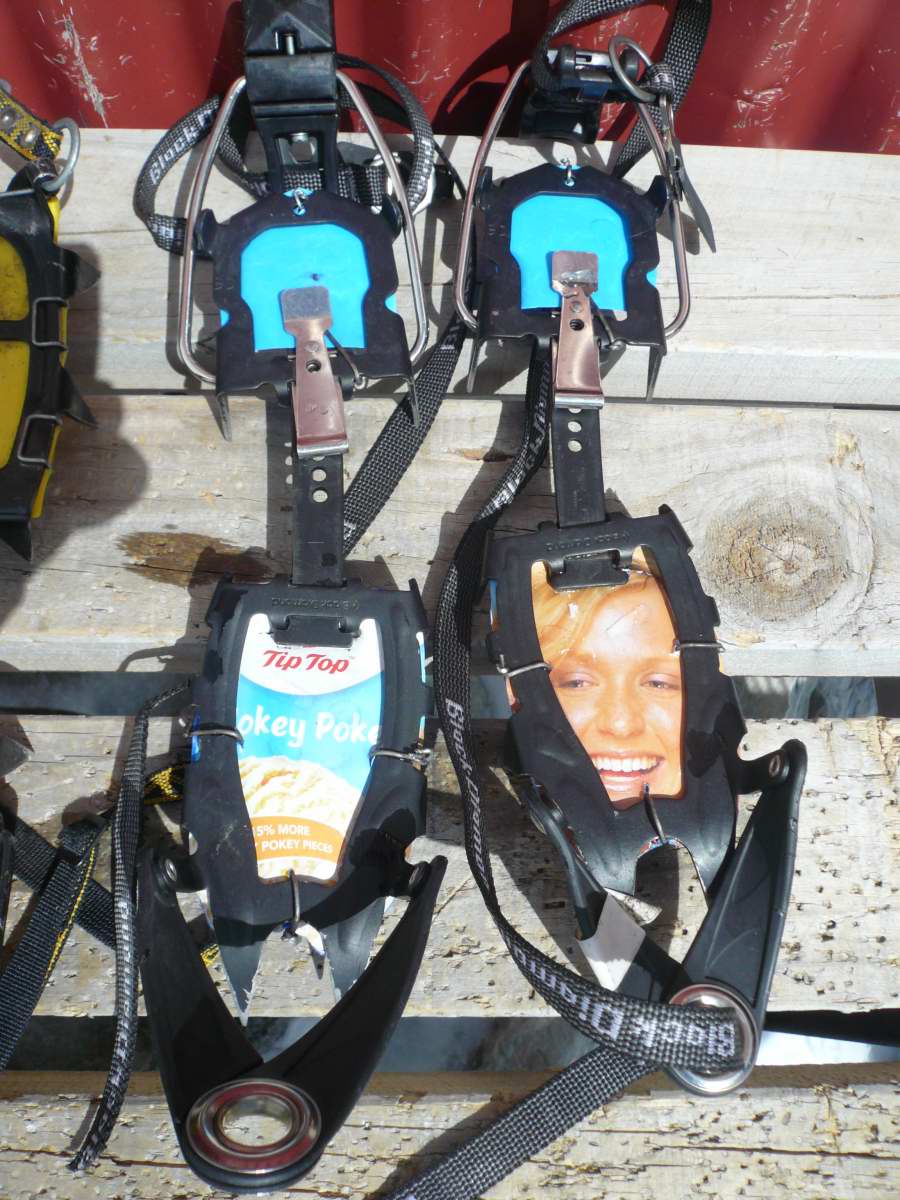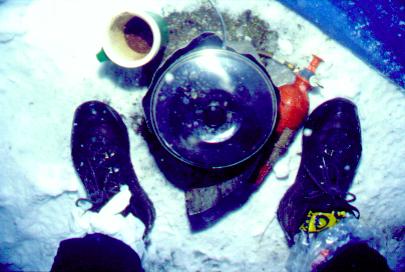| Upcoming Expeditions |
||||
WorkShop Manual -Tips, Trix, & Topos
-
Crampon strap Modification Crampon & Anti-ball plates
-
Boot and Foot maintenance
-
Knee Joint protection - Solution: The Wayatt Lock-Step?
-
Tararua Oat Buscuits Recipe by Beryl W.
GW's " Gladiator" crampon straps-Nov. 2011


Improved Crampon/Boot Security - GW's modified Bail crampon straps
see MountainRec News
ANTI-BALL PLATES
Snow balling within crampon spikes can be a significant safety issue particularly in the early/mid summer period. Anti-ball plates significantly lessen balling up. Either purchase plates to suit your plates or custom-cut them out of ice-cream or drench containers and wire up using ski area ticket wires. (handy for your repair kit too!)


GW's custom anti-ball plates and Neoprene boot inserts.
NEOPRENE BOOT INSERTS (Nov. 2011)
Sick of snow sitting on your boots lace/tongue area and getting cold & wet feet. Solution: Slot a wedge of 3mm neoprene under the laces.
SWOLLEN FEET?
I noticed my feet swell up after a long descent only to be pleasantly cooled and shrunk by a cold stream crossing. For the next 1/2 hour you are walking on air.
FOOT WORK?
In his book Mountain Solitudes, Aat Vervoon, talks about ongoing foot and boot fitting problems. Many of them would have been resolved by: Selecting the correct flex of boots for the intended journey. Full shank climbing boots aren't designed for long valley walks. Consider the best flex for your journey. Pre-tape up your feet and shins, if you must complete a walk in heavy climbing boots. If you have serious unresolved foot/boot issues check in with your local ski-boot fitter (or me!)
BAGGIES: One of my friends, a former Olympian, is bothered by blisters so runs with plastic bags inside his running shoes to minimise friction. This would work with heavier boots and would also provide a vapour barrier in cold, wet conditions.

BOOTS TOO NARROW ACROSS TOES?
Here's my field solution. Press out the toe space with a wooden broom handle cut slightly longer than your foot width. Place it in your boot each night to maintain the width as the leather has a memory for it's former shape. Use a blister kit patch immediately on any hot spots. Place on a dry foot.
If the shins are getting sore (Unlikely with Super Mountain 9 Guides) don't lace the top two hooks. If damage has already occurred, tape some thin (3mm) closed cell foam over the sore area to provide padding.
IMPROMPTU PUTTEES: Forget your gaiters and your are getting into snow country? Cut a hole in the toes of some old socks and create some tube puttees.
Boot Odour? (Yes, you'll need some with the high tech. Mid Exits.)
I recommend Gran's Remedy, Dunedin made. $18.45 for 6 months treatment. They say it's guaranteed too!
Tru-Boot Story from Rebecca Wayatt, Aspen, Colorado(1999)
Rebecca was fitting out some kids with boots for a ski lesson when she noticed one young person with a left boot on her right foot and right on the left.
"You've got the boots on the wrong feet Buddy", she said.
"A dismayed child replied, "But these are the only feet I have!
Beaten, but not Out!
I recently put my 2 year old Salomon Mid Exits through the gruelling task of traversing the Copland Pass, 2135m, following 2 summers of full time mountain activity.
The Copland Pass crossing included 5 hours of moraine and scree, steep rock ridge climbing, snow and ice climbing w/crampons, glissading down snow and two days of wet valley tramping.
Both the owner and boots have emerged battle weary but relatively unscathed. A testimonial to the quality construction.
I recall teaching a 4 day alpine rock-climbing course on the Remarkables . We did some great pitches, got snowed on and had to rescue a tent which blew into lake Alta. My old Mid Exits were soaked , so I plastic bagged my feet in dry socks for the exit "death march" in toasty feet. Get's easier? If it did get easy, then everyone would be doing it!
Buying Boots/ avoiding blisters
Geoff Wayatt, MountainRecreation
Can one boot fit all people for all seasons? Just ask an Army Soldier!
Next to food, the wellbeing of my feet is my highest outdoor priority.
To achieve the optimum fit, comfort and performance I follow the following steps when visiting a boot retailer:
-
What tasks are the boots to perform? (Summer or Winter; valley or alpine; one to multi day trips; on tracks or wilderness terrain)
-
Access Boots or Climbing Boots? Few boots fit both tasks and it’s worth noting that studies for the ’53 Everest Exp. found 1lb on the feet equalled 4lbs. On the back. I generally carry my climbing boots up long valley access tracks.
-
ACCESS BOOTS - Base the model format selection on other boots already owned and used. (Once you find a good reliable brand and boot – consider buying a 2nd pair and rotating their use)
-
Consider the foot fit of the boot without critical reference to the brand or sizing. (Brands often vary by a ½ size)
-
Examine the sole tread and texture along with the upper construction (Generally the quality of the boot will relate to it’s price level. For me a soft grippy sole is a paramount consideration)
-
Foot length is more important than volume. (Adding spare inner soles can easily decrease the boot volume. Custom orthopaedic footbeds are even better!
-
Sole Stiffness is a very important consideration for both foot comfort and performance. A half shank sole is good for tramping but not steep ice slopes. However the stiffer soled boots are less forgiving on the flats, so heel rubbing and blisters are likely, unless you tape your feet.
-
Ankle Support and protection can be gained by choosing a mid or high ankle boots. Low ankle height gives complete ankle movement for tri-athletes. I prefer the anklebone protection and relative freedom of the mid height access boots. I recommend higher boots to tall climbers because their height increases the leverages and the risk of ankle sprain.
-
CLIMBING BOOTS - It is easier to get an adequate fit in plastic boots with liners. The liners reduce rubbing and blisters. Plastics are generally lighter and cheaper, but lack the ankle flex and feel on foot/rock contact of leather boots.
-
Plastic Boot fitting – take out the liner and check your foot length in the plastic shell 1st. Foot width isn’t too important as plastics can be easily widened with a hair dryer and short piece of broomstick.
BLISTERS: Some years ago I discussed mtn. medicine with eminent eye surgeon and mountaineer, Sir Randall Elliott. Contrary to my initial thoughts of performing operations with a Leatherman, he said. "Do you know what, I think, we really need in outdoor 1st aid instruction? Asked Randall. "Well… no? " I replied "Good blister treatment!" he stated. "If we improve our management of blisters and we’ll significantly increase the general enjoyment of the outdoors.
Remember to carry tape, a blister kit and 2nd skin and treat "hot spots" immediately. 2nd Skin is excellent for filling the crater left by a ruptured blister.
TRIX! CLIMBERS KNEE-the pre-op solution?
Ó Geoff Wayatt,MountainRec,Wanaka, NZ
Three years ago I developed the "Wayatt Lock Step" to limit the jarring and impact load on the knees. Recently I came on another protective technique:
WRAP-UPS: Inspired by watching the Atlanta Olympic weightlifting on a rented TV, I summarised: "If weightlifters support their knees with bandages while lifting massive weights, why don’t bushwalkers and climbers do it before massive or awkward descents?
I put this to Ken Asher (Townsville Gym) as we crossed the Copland Pass last November. "We call them wrap-ups." he said, endorsing the concept.
I’ve since used them during the summer when I’ve had heavy loads or long descents and benefited from the additional support. To gain optimum support it’s important to buy quality, 12cm elastic bandages and wrap for supportive tension.
Combined with the Wayatt Lock-step, I think I’ve found the ultimate pre-op solution for fading climbers knees!
TRIX! LIPSCREEN NECK CORD by Ó Geoff Wayatt, MountainRec April 1999
Ever found yourself searching through pockets or pack for a tube of lip creme?
A few thoughtful manufacturers have included a colourful neck cord attached to their lip-creme easy access. If your favourite lip creme lacks a cord it’s easily remedied with a one meter length of soft cord knotted and taped to the base of the tube. Place the creme close to your body to avoid cord tangles and to keep the creme soft and easy to apply. Useful for tight belay ledges and -on the move-ski touring, kayaking situations.
Alternatively, a Sydney skin specialist/ ski mountaineering friend of mine who will remain nameless, keeps her "sun sense," a particularly stiff, but effective creme in her bra for convenient, personal use.
The concept can be extended to attaching a lighter, mini swiss army knife or torch for those who suffer frequent bouts of forgetfulness. "Now, where is that string?"
TRIX! LIGHTER LOOP:
Last Dec. I arrived at isolated Empress hut, Mt. Cook Nat. Park tired and keen to get a quick brew going on the stove. Often you can’t find matches quickly or there’s an old box sitting on a wet bench. On this occasion I couldn’t believe my luck.
Hanging from a nail above the bench was a lighter.
An ingenious climber had taken a "twistie" bread bag tie, formed a "horseshoe shape and taped it to the base of the lighter. It’s proved useful on my workshop wall could be securely clipped to that great key-ring clip some pack manufacturers put inside their top pocket.
TRIX! CONVERTING AN EXPEDITION PACK TO A DAY PACK
On day trips and climbs in the middle of an extended trip I have found carrying a bulky 80 litre pack an impediment. The simple way to reduce the volume is to tighten up the side straps. Unfortunately a bulky over filled top pocket tends to flop about and can be slow to clip and unclip.
A chance acquisition of a micro light karabiner led me to leaving it on the pack haul strap for a convenient clip-off onto my anchors. I then discovered I could stuff the top pocket into the throat of the pack leaving clear access to the pocket zip compartment. To secure the pack contents I simply clipped the karabiner attached to the haul strap to the compression buckle loop on the other side of the throat. If your pack doesn’t have the loops the add-ons involve very simple machining. Wrap the main pack straps away in the crampon shock cords. Try it and you’ll never have to experience your pack pocket thumping your head again.
"I was heel hooked by a Kea" – an easy explanation for those phantom face-plant crampon trip-ups, while view-gazing & crossing flat snow.
TARARUA OAT BISCUITS RECIPE
"Guaranteed to break your teeth and give you constipation, our Matukituki Jaw breakers have proven so popular we invite you to try your own variation. It's basic: throw in whatever suitable cereal is handy. I once added some 2yr old/ex Jannu Exp cornflakes to one batch and they set like concrete!" Beryl Wayatt
Recipe
2.5kgs of a combination of Rolled Oats, wheat-germ, wholemeal flour, bran, oatmeal, weet-bix etc.
500gms of brown or raw sugar
400gms Butter
2 heaped tablespoons of golden syrup
Water to mix
Rub butter into dry ingredients. Add golden syrup and water and mix to a "rolling out" consistency. Roll into 5mm thickness and cut 5cm squares. Bake in a slow oven until brown. The longer the cooking time, the harder the Tararuas".
(The biscuits get their name from the rugged and uncompromising Tararua Range north of Wellington.)
